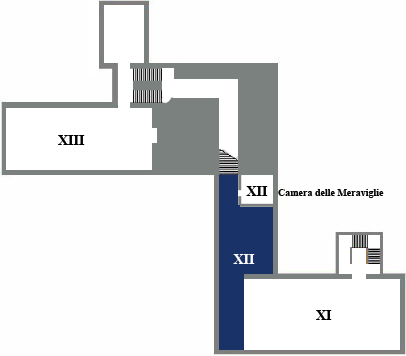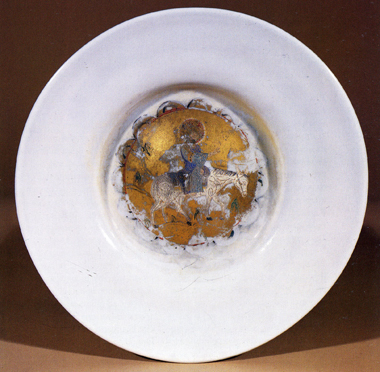|

Room XII houses ancient, mediaeval and modern art objects: brightly-coloured archaeological glassware, a selection of filigree, etched, painted Venetian glassware. On display are also important terracotta sculptures and majolica vases.
|
|
Mediterranean Area
Alabastra
6th-5th century B.C.
These small brightly-coloured ampoules, called alabastra, were used as containers for ointments and perfumes. This type of alabastron, which was widely used in the Mediterranean basin for a very long time, from the 6th to the 1st century B.C., has been discovered in different parts of a vast geographical area: from the Black Sea to the Balkans and as far as Gallia.
This type of artefact was produced with the technique of the friable nucleus, i.e. a nucleus of clay and grass was prepared, probably wrapped in an extremely light cloth and then pressed around a metal rod; this was then immersed in the sticky melted glass. At the end of the operation, when the glass had completely cooled, the nucleus was removed. The filigree decoration was applied subsequently, the ampoule being turned manually to compose elegant zigzag, plumed or garland patterns.
|
|
Roman Art
Small gold-banded bottle
from mid-1st century B.C. to 1st century A.D.
The bottle is an extremely refined example of a household artefact, and was almost certainly used as a balm-jar. It was made with complex techniques, perhaps in Egyptian workshops probably centred in Alexandria, although it cannot be ruled out that the specialised workshops were active in Italy.
There is a very limited number of such products, less than twenty, and the period to which they belong is also very limited, from mid-1st century B.C. to the beginning of the 1st century A.D.
|
|
Venetian Art
Redeemer blessing the crowd from the ass
second half of 13th century
The gilded, etched glass panel is inserted into a plate of modern manufacture. The panel, which takes its inspiration from Hellenistic classicism and the final mediaeval wave of Byzantine artistic culture, and shows the Redeemer blessing the crowd from the ass, is a typical example of highly-specialised Venetian production.
The technique used in working the panel, which was well-known in the late imperial era, and found in the 3rd and 4th centuries A.D., consisted of using the glass as a support and applying the gold leaf cold on the back, then drawing or etching the figures and applying a dark varnish which enhanced the background gilding. The artefacts thus obtained, which imitated the costlier enamelled and nielloed products, were used to decorate small gold religious objects, or as friezes for the decorations inside marble slabs in pulpits.

|
|
Venetian art
Vase with coat-of-arms of Tiepolo family
1620-30
The surface of the vase, with its gently curved body and flared base, is covered with gold leaf from its neck to the beginning of the base and decorated with a scallop pattern and variously-coloured enamel dots. Towards the bottom the pattern is broken by the coat-of-arms of the Tiepolo family. The decoration is typical of Renaissance Murano glass manufacture and was used to embellish glassware and luxury objects. This object precisely echoes other similarly-decorated glass objects belonging to the noble Tiepolo family.
|
|
Francesco Laurana
Young saint (St. Lawrence?)
mid-15th century
The head of a Young saint with its delicate, noble features, whose original polychromy is now lost, belonged to a life-size statue which probably stood in a niche, as the sketchily-worked back part would seem to indicate. The terracotta sculpture is the work of Francesco Laurana, a great Dalmatian artist working around the mid-15th century at the Aragonese court of Naples and later in France. The work, which is of considerably high quality, seems to have been modelled on a cloth core wrapped round a wooden support, which was then eliminated during drying through an opening at the top of the head.
|
|
Benedetto da Maiano
Mourning Madonna
last decade of 16th century
The half-figure of the Mourning Madonna was probably part of a group of terracotta statues, a four-figure lamentation scene (compianto) composed of several separately-fired pieces. The polychrome figure, perhaps modelled on an inert core, was then emptied before firing, creating uniform, thin contours and deep cavities under the mantle. The anatomical definition of the face, which is no longer young and shows the signs of age, the sentimental intensity and the ample drapery are stylistic elements which are sufficient to support its attribution to Benedetto da Maiano. This important sculptor of the Florentine artistic scene was particularly interested in terracotta sculpture and expressed a naturalistic and monumental vein which make him a forerunner of the 16th-century style.

|
|